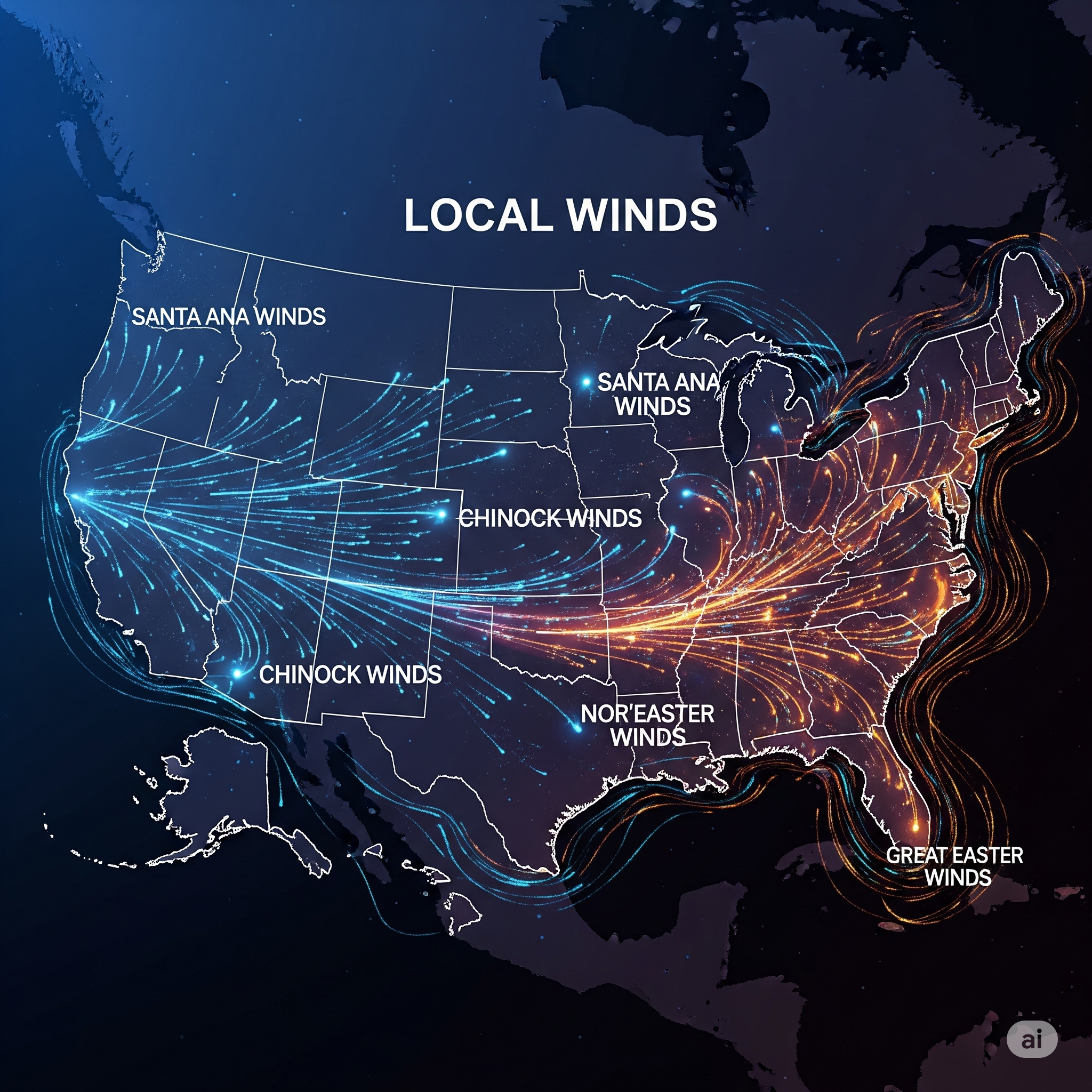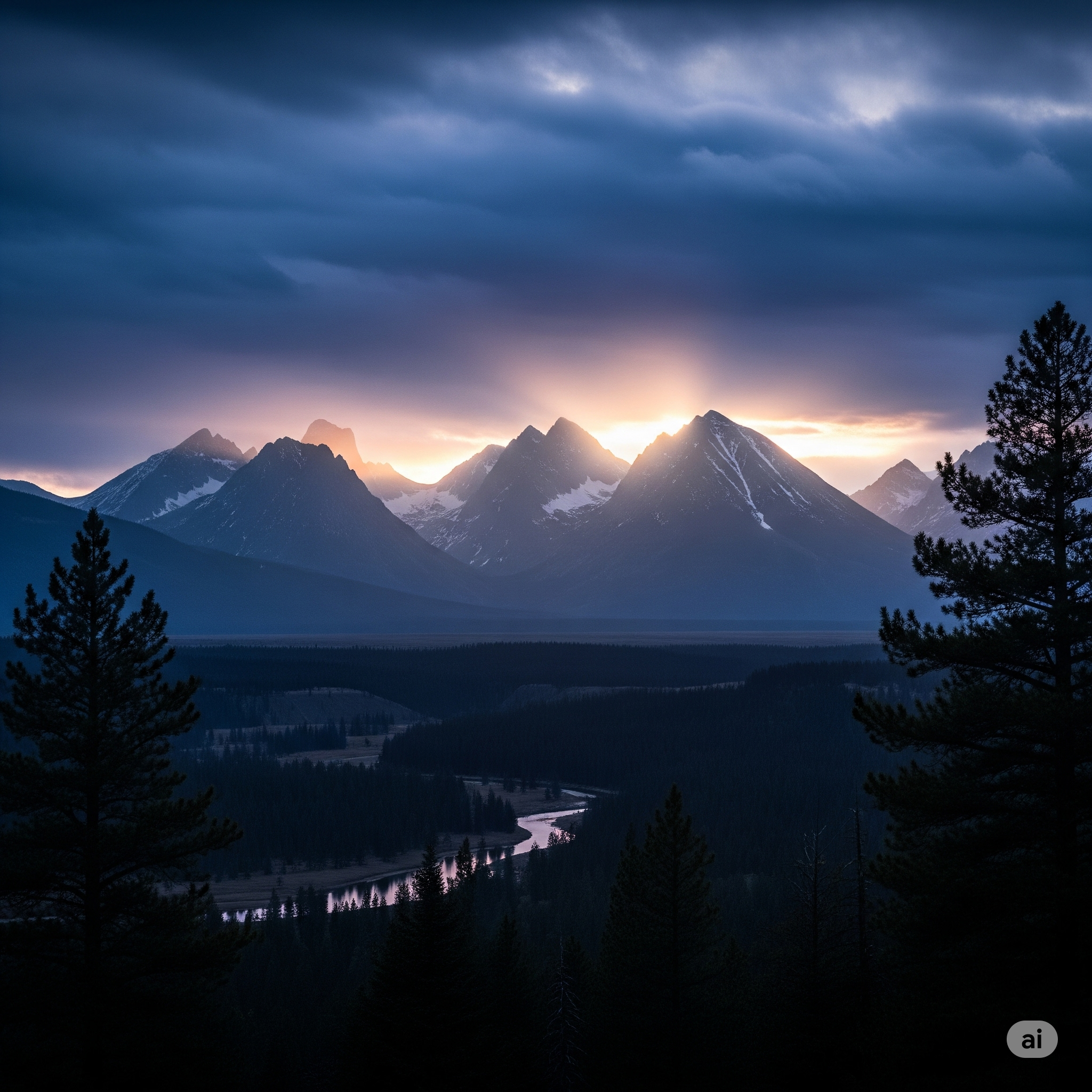Introduction
The United States spans mountains, deserts, prairies, vast lakes, and three major coasts. That variety creates distinct local winds—recurring wind patterns tied to terrain, water, and daily heating/cooling cycles. These winds don’t just make for colorful weather; they influence where people live, how homes are built, wildfire risk, energy use, transportation, and what farmers plant, water, protect, and harvest. This guide explains the major local winds of the USA, why they form, and their practical effects on daily life and agriculture.
How Local Winds Form (Quick Mechanisms)
- Sea/Lake breezes: Daytime heating makes land warmer than water → air rises over land → cooler air flows in from water (onshore breeze). At night, the flow often reverses (land breeze).
- Gap winds: Air is funneled through mountain passes or canyons, accelerating like water through a nozzle.
- Foehn/Chinook (downslope) winds: Moist air rises up a mountain, loses moisture, then descends the lee side, warming and drying adiabatically—often very gusty and warm.
- Katabatic winds: Cold, dense air drains downhill from high terrain or ice/snowfields (e.g., Alaska fjords), sometimes violently.
- Outflow “gust fronts” & haboobs: Thunderstorms push dense, cool air outward; in arid regions it can loft dust into dramatic walls.
- Low-level jets: Nighttime temperature inversions over the Plains spawn narrow corridors of fast winds a few hundred meters above ground—important for moisture transport, storms, and wind energy.
The Local Winds of the USA (By Region)
West Coast & Interior West
- Santa Ana winds (Southern California): Hot, very dry downslope winds rushing from high-pressure deserts toward the coast via passes. Known for extreme wildfire spread, power shutoffs, and low humidity.
- Diablo winds (Northern California): Similar foehn-like, hot/dry offshore winds affecting the Bay Area and wine country, typically in autumn.
- Sundowner winds (Santa Barbara area): Evening downslope winds off the Santa Ynez Mountains; sharp temperature spikes and fire danger.
- Mono winds (western Sierra Nevada): Episodic strong downslope winds causing tree damage and power disruptions in the Central Valley and foothills.
- Chinook winds (Rockies & High Plains east of the Continental Divide): Warm, dry downslope winds in MT, WY, CO, sometimes melting snow rapidly—nicknamed “snow eaters.”
- Columbia Gorge east winds (Oregon/Washington): Cold or hot air funneled through the Gorge, infamous for winter ice storms west of the Cascades and world-class windsurfing.
- Fraser outflow (Whatcom/Skagit counties, WA): Bitterly cold air from interior British Columbia surges through the Fraser River valley into the Salish Sea—wind chills, coastal sea smoke.
Alaska
- Williwaws: Sudden, violent katabatic gusts along fjords and coastal mountains—hazardous to boats and small aircraft.
- Taku winds (Juneau area): Strong downslope/katabatic winds that can exceed hurricane force in rare events, closing roads and ports.
Hawaii
- Northeast trade winds: The default state—moderate, steady onshore flow bringing clouds/showers to windward slopes; essential to island climate, air quality, and surf.
- Kona winds: Southerly winds (trade wind “reversal”) that produce muggy weather, volcanic smog (vog) distribution, and heavy rains on opposite slopes.
Southwest & Intermountain West
- Canyon and gap winds (UT, AZ, NM, NV): Local accelerations through canyons and mesas; can combine with thunderstorm outflows.
- Haboobs (AZ/NM deserts): Dust-laden outflow winds from collapsing thunderstorms—sudden visibility drops, respiratory/transport hazards.
Great Plains & Midwest
- Plains low-level jet (TX–KS–NE–IA and beyond): Nocturnal wind ribbon that feeds moisture to storms, boosts wind energy production, and can cause nighttime turbulence.
- Blue Norther / Northers (TX & central states): Colloquial for fast-moving cold surges with sharp wind shifts and temperature drops—hard freezes in citrus/vegetable zones if they reach far south.
- Chinook influence (eastern CO, WY, MT): Winter warmups that melt snowpack and dry fields quickly.
Great Lakes
- Lake breezes & land breezes: Daily onshore/offshore cycles that moderate temperatures near shorelines, influence fog, and steer lake-effect clouds.
- Gales (especially autumn): Strong pressure systems generate severe lake winds and waves—marine hazards, shoreline erosion.
Northeast & Mid-Atlantic
- Sea breezes (New England to the Mid-Atlantic): Summer relief along the coast, but can trigger thunderstorms inland.
- Nor’easter winds: While a synoptic-scale storm type, the coastal wind regime (persistent NE winds) defines these events—coastal flooding, beach erosion, power outages.
- Cold-air damming (“the wedge”): Shallow, cold air trapped east of the Appalachians produces persistent northeasterly surface winds, icy conditions, and raw weather.
Southeast & Gulf Coast
- Gulf sea breezes: Moist onshore winds that spark afternoon thunderstorms; crucial to summertime rainfall in FL, AL, MS, LA, TX coasts.
- Post-frontal northerlies: After cold fronts, cool/dry continental air sweeps south—wind chill, wildfire potential in drought.
How These Winds Shape Daily Life
Homes, Cities, and Infrastructure
- Building codes & siting: Wind-prone regions adopt stricter roofing/anchoring; utilities in California now de-energize lines during severe offshore wind events to reduce wildfire ignitions.
- Urban design: Sea-breeze corridors are preserved in some coastal cities to ventilate heat and pollution; wind tunnels around high-rises are managed with setbacks and landscaping.
- Power reliability: Gap winds, Chinooks, and katabatic events can down trees/lines; Santa Ana/Diablo periods may bring planned outages.
Everyday impacts (quick hits):
- Wind chill and heat stress management (clothing, hydration).
- Dust/allergen exposure (haboobs, spring winds on plains).
- Air quality: Offshore winds can push smoke/ozone inland or out to sea; Kona winds transport volcanic vog.
- Transportation: Crosswinds affect bridges, highways with high-profile vehicles, and aircraft operations; marine advisories on coasts and lakes.
- Recreation & culture: Surf, sailing, kites, and wind sports flourish in known corridors (Columbia Gorge, Great Lakes, Outer Banks, Maui’s north shore). “Chinook arches” and Santa Ana lore permeate local culture.
Energy & Economy
- Wind power siting: The Plains low-level jet underpins world-class wind energy in TX, IA, OK, KS, ND/SD.
- Heating/Cooling demand: Santa Ana/Diablo events spike cooling demand; cold outflows boost heating loads.
How Winds Affect Agriculture (Nationwide Themes)
- Temperature & Frost Protection
- Chinook warmups can reduce mid-winter snow cover—beneficial for livestock access and winter wheat grazing but risky if a hard freeze follows without insulating snow.
- Sea breezes temper coastal heat, protecting cool-season vegetables and berries.
- Radiation frost vs. wind: Light winds can prevent frost by mixing warmer air aloft; many orchards use wind machines or helicopter downdrafts on clear, calm nights. Strong, dry winds, however, increase frost injury risk by desiccating blossoms.
- Chinook warmups can reduce mid-winter snow cover—beneficial for livestock access and winter wheat grazing but risky if a hard freeze follows without insulating snow.
- Moisture Balance & Irrigation
- Evapotranspiration (ET): Hot, dry winds (Santa Ana, Diablo, Sundowners, Chinooks) accelerate ET, raising irrigation demand and stressing crops like avocado, citrus, almonds, grapes, leafy greens.
- Sea/lake breezes bring cooler, humid air that can reduce ET, lowering irrigation needs near coasts or lakeshores.
- Kona winds may raise humidity and disease pressure on windward crops.
- Evapotranspiration (ET): Hot, dry winds (Santa Ana, Diablo, Sundowners, Chinooks) accelerate ET, raising irrigation demand and stressing crops like avocado, citrus, almonds, grapes, leafy greens.
- Wind Damage & Lodging
- Gusty foehn or gap winds can lodge cereals (wheat, barley, oats), snap corn, shred leaves, and scar fruit.
- Vineyards erect trellis designs and windbreaks to limit canopy damage; delicate blossom phases (stone fruits, almonds) are particularly vulnerable.
- Gusty foehn or gap winds can lodge cereals (wheat, barley, oats), snap corn, shred leaves, and scar fruit.
- Soil Erosion & Dust
- Haboobs and spring winds can erode bare soils, sandblast seedlings, and bury rows.
- Farmers mitigate with cover crops, residue retention (no-till/min-till), strip tillage, and shelterbelts (windbreak tree rows).
- In the Great Plains and Southwest, wind erosion risk mapping and conservation programs guide field layout and fallow management.
- Haboobs and spring winds can erode bare soils, sandblast seedlings, and bury rows.
- Pests, Diseases, and Pollination
- Wind-driven spores & vectors: Humid sea-breeze regimes can favor foliar diseases (mildews, blights) and spread spores downwind; dry winds suppress some fungi but can carry aphids/whiteflies between fields.
- Pollination: Moderate winds aid pollen dispersal for corn and small grains, but strong winds reduce pollinator activity (bees avoid flying), lower fruit set in almonds, apples, blueberries, and increase flower abscission in grapes and citrus.
- Salt spray near coasts on onshore winds can burn leaf edges in sensitive crops.
- Wind-driven spores & vectors: Humid sea-breeze regimes can favor foliar diseases (mildews, blights) and spread spores downwind; dry winds suppress some fungi but can carry aphids/whiteflies between fields.
- Wildfire & Smoke Exposure
- Santa Ana/Diablo/Sundowner winds intensify wildfires, threatening orchards, vineyards, and rangelands; smoke taint in wine grapes is a known hazard.
- Farm operations adapt with defensible space, emergency water storage, and harvest timing around smoke episodes.
- Santa Ana/Diablo/Sundowner winds intensify wildfires, threatening orchards, vineyards, and rangelands; smoke taint in wine grapes is a known hazard.
- Logistics & Field Operations
- Strong winds delay spraying (drift risk), affect aerial application, and complicate plastic mulch laying, transplanting, and harvest of light crops (e.g., leafy greens).
- Grain drying/aeration uses windy, dry conditions to advantage; hay curing is faster but leaf shatter can reduce quality.
- Strong winds delay spraying (drift risk), affect aerial application, and complicate plastic mulch laying, transplanting, and harvest of light crops (e.g., leafy greens).
Regional Snapshots for Farmers & Communities
California & the West
- Challenge: Hot, dry downslope winds (Santa Ana/Diablo/Sundowner) → fire risk, rapid crop water loss, fruit scarring.
- Adapt: Drip irrigation, antitranspirant sprays (selectively), windbreaks, trellis reinforcement; schedule sprays at low-wind dawn/evening; maintain fire breaks, screen intakes during dusty episodes.
Pacific Northwest
- Challenge: Gorge east winds and Fraser outflows → winter cold injuries in nurseries, berries, wine grapes; windthrow in timber stands.
- Adapt: Site-sensitive cultivar selection, row orientation with prevailing winds, cold protection (row covers, fans), and orchard windbreaks.
Great Plains & Rockies
- Challenge: Chinooks and spring winds → ET spikes, soil erosion, lodging in cereals; dust storms in drought.
- Adapt: Conservation tillage, cover crops, residue management, field shelterbelts; flexible irrigation scheduling tied to daily ET and wind forecasts; choose shorter, sturdier cultivars in high-wind zones.
Southwest & Desert Agriculture
- Challenge: Haboobs and canyon winds → dust abrasion, transplant desiccation, visibility hazards for harvest crews.
- Adapt: Staggered planting to avoid peak outflow seasons; wind fences, mulches, high-frequency irrigation during windy heat waves; schedule harvests outside gusty afternoon windows.
Great Lakes
- Challenge: Persistent lake breezes can delay heat accumulation (growing degree days), shift storm timing, and increase localized disease pressure.
- Benefit: Temperature moderation for cherries, apples, grapes; reduced frost in some setups due to mixing.
- Adapt: Disease forecasting models keyed to onshore wind humidity; fungicide timing between breeze cycles; siting orchards along favorable lake-effect microclimates.
Northeast & Mid-Atlantic
- Challenge: Nor’easter winds → salt spray and mechanical damage; cold-air damming prolongs wet, chilly spells delaying fieldwork.
- Adapt: Wind-tolerant trellis and row covers; buffer plantings against salt; drainage and soil trafficability improvements for prolonged wet winds.
Southeast & Gulf
- Challenge: Sea-breeze thunderstorms complicate spray windows; post-frontal northerlies can trigger radiation frosts in Florida citrus/vegetables after calm nights.
- Adapt: Use sea-breeze timing to plan applications and harvests; deploy frost irrigation and wind machines; coastal windbreaks against salt spray.
Hawaii
- Challenge/Benefit: Trades ventilate fields, limit heat stress, and suppress some disease; Kona winds bring vog and heavy rain to normally leeward areas.
- Adapt: Crop siting by windward/leeward gradient; protective structures for sensitive ornamentals; monitor sulfur deposition during vog episodes.
Alaska
- Challenge: Williwaws/Taku damage high tunnels, greenhouses, and fisheries infrastructure.
- Adapt: Heavier anchoring, low-profile structures, wind-aware siting, and robust marine/aviation planning.
Practical Playbook: Living and Farming with the Wind
For communities & households
- Know your prevailing wind seasons (e.g., Santa Ana autumn peaks; spring Plains winds).
- Fire readiness: clear defensible space, harden structures, consider backup power in de-energization zones.
- Health: keep N95 masks for dust/smoke days; manage indoor ventilation during poor air quality or vog.
For farms & ranches
- Windbreak strategy:
- Multi-row shelterbelts (tall–medium–shrub tiers) reduce wind speeds across fields, cutting ET and erosion.
- Site windbreaks perpendicular to damaging winds; maintain porosity (~40–50%) to avoid turbulence.
- Multi-row shelterbelts (tall–medium–shrub tiers) reduce wind speeds across fields, cutting ET and erosion.
- Irrigation & ET:
- Track daily ET (with wind factor) and adjust irrigation during hot, dry wind events; consider deficit irrigation strategies on perennials only with expert guidance.
- Track daily ET (with wind factor) and adjust irrigation during hot, dry wind events; consider deficit irrigation strategies on perennials only with expert guidance.
- Soil protection:
- Keep cover on soil (cover crops/residues), especially pre-monsoon or pre-storm seasons; use strip till/no-till to anchor topsoil.
- Keep cover on soil (cover crops/residues), especially pre-monsoon or pre-storm seasons; use strip till/no-till to anchor topsoil.
- Crop & variety selection:
- Favor short-stature cereals in high-wind counties; select thicker-cuticle leafy crops or schedule plantings to dodge gusty windows.
- Favor short-stature cereals in high-wind counties; select thicker-cuticle leafy crops or schedule plantings to dodge gusty windows.
- Canopy & trellis design:
- Secure trellises (grapes/berries), add catch wires; prune for balanced canopies to reduce sail area before windy seasons.
- Secure trellises (grapes/berries), add catch wires; prune for balanced canopies to reduce sail area before windy seasons.
- Critical phenology protection:
- Shield blossoms (e.g., portable wind fences), deploy wind machines on frost nights, and use bee-friendly wind breaks to support pollination.
- Shield blossoms (e.g., portable wind fences), deploy wind machines on frost nights, and use bee-friendly wind breaks to support pollination.
- Operations timing:
- Spray when winds are consistently below drift thresholds; avoid laying plastics or transplanting during forecast gusts.
- Spray when winds are consistently below drift thresholds; avoid laying plastics or transplanting during forecast gusts.
- Risk management:
- Keep wind riders in insurance policies where available; document wind damage events; build emergency response for smoke/wildfire and dust.
Summary Takeaways
Smart adaptation—windbreaks, conservation tillage, irrigation tuning, trellis engineering, spray/harvest timing, and region-appropriate crop choices—turns wind from a liability into a managed variable.
The USA’s signature local winds—Santa Ana, Diablo, Sundowner, Chinook, Gorge east winds, Fraser outflow, williwaws, Taku, trades & Kona, sea/lake breezes, haboobs, low-level jets, Blue Northers, and nor’easter regimes—arise from terrain funnels, mountain/valley effects, land–water contrasts, and frontal/outflow dynamics.
For daily life, winds affect fire safety, air quality, power reliability, transport, recreation, and building standards.
For agriculture, winds shape frost risk, evapotranspiration, irrigation demand, lodging, disease/pest spread, pollination, soil erosion, and wildfire/smoke exposure.




